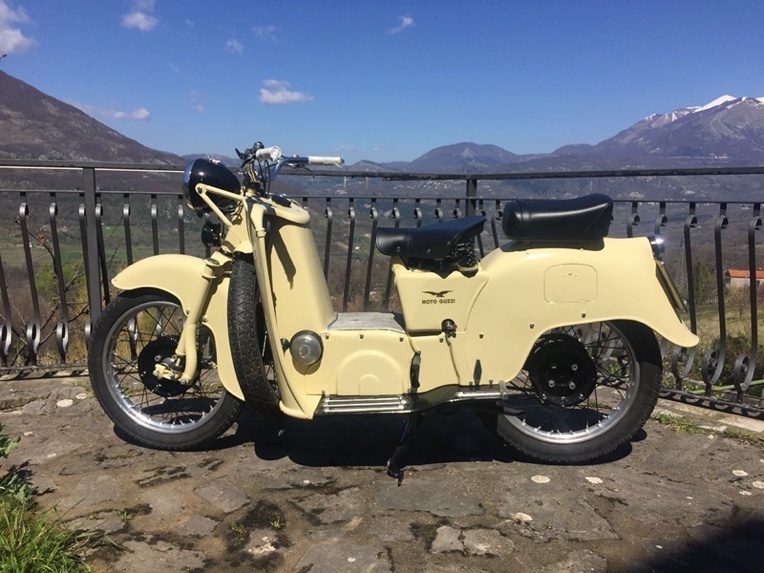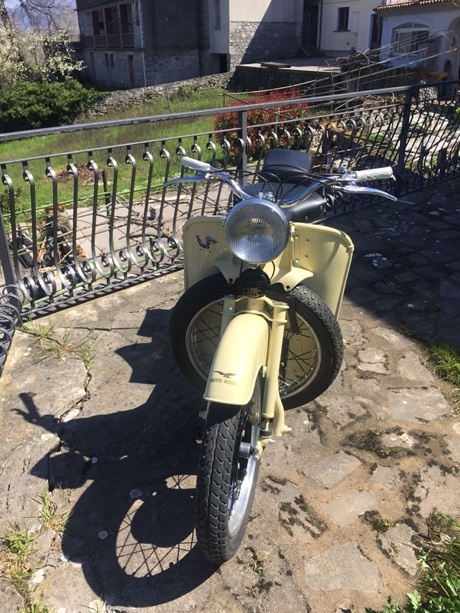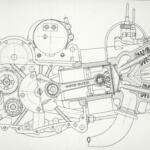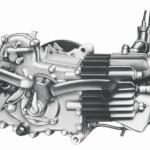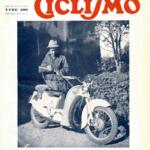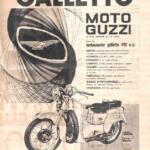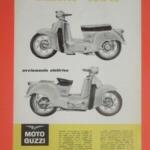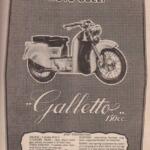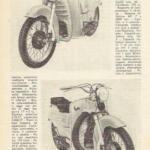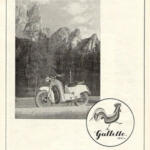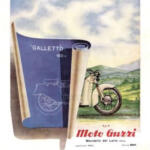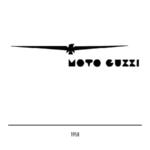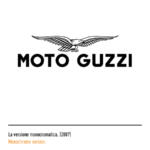Moto Guzzi Galletto, a name that the old generation would have aroused in the memory of many the memory not of a simple motorcycle, but of a revolutionary innovation in the field of two wheels.
The Galletto was born from an idea of the founder of the motorcycle manufacturer, Carlo Guzzi. Guzzi already towards the end of the Second World War, wanted to create a hybrid vehicle that would combine the best features of a motorcycle with those of a scooter, thus trying to eliminate the drawbacks of both. In fact, the motorcycle has excellent cycling and engine characteristics typical of a motorcycle, combined with ease of use and excellent protection provided to the driver typical of a scooter. There was also the possibility of adding (optional) a spare wheel mounted in front of the front shield to change the tire in the event of a puncture, very frequent in those years when the roads were not yet all well paved.
The Moto Guzzi Galletto brought with it many technical revolutions: the compact engine was placed at the bottom in the center, the rear suspension had a tubular single arm that carried an eccentric hub that greatly simplified the disassembly of the wheel and the chain tension.
The prototype was presented to the public for the first time at the Geneva Motor Show in 1950, immediately finding great success thanks to the innovative idea of a hybrid vehicle that would revolutionize the concept of mobility on two wheels.
The name of the motorcycle-scooter derives from the logo which was decided to draw on the front shield in the upper right part, a colored rooster. The choice of the logo was long and troubled, started from black and white sketches with only the head of the rooster up to the definitive version as we know it today, a whole colored cock.
 |
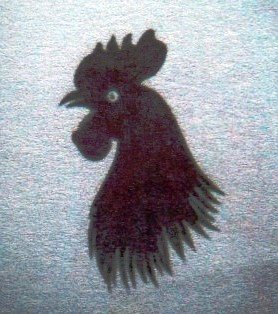 |
 |
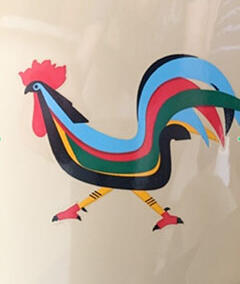 |
For the Galletto, bronze castings representing a rooster were also created, these were offered as extras by the dealers for the most important customers.

The choice of the color to adopt was not difficult. The owner of the Mandello house, in fact, as soon as he returned from a safari in Africa, decided to use a beautiful beige sand-colored paint, a tint that reminded the designer of the African colors he was very fond of.
The Galletto went into production in the early 1950s, but over time it developed into different versions and engine cubic capacity.
The “Galletto 160” marketed for the first time in the early months of 1950 was declined in four types, each having technical evolutions of the previous model.
The “Galletto 175“, evolution of the 160 fourth type model which brings with it all the related technical improvements, was produced from 1952 and 8660 specimens were sold.
Finally, the “Galletto 192“, 192 derives from the cubic centimeters of the engine which becomes larger and more powerful and gains a fourth gear compared to the previous model.
The latter version was marketed in early 1954, so four years after the official launch of the first prototype.
In total 71,060 specimens of the “Galletto” were built between 1950 and 1966.
I had the opportunity to try a Galletto 192 last series, obviously it would make no sense to compare chassis and performance with recent models of the same “motorcycle-scooter” category. However, I can describe the different sensations that you have in riding a vintage motorcycle like this compared to the more recent models.
The first thing to get used to when getting into the saddle is the position of the gearbox, the pedal is in fact on the right unlike all the other bikes and the gear level has the shape of a rocker arm, creating an additional element of difficulty since the the insertion of the gears is inverted with respect to the current models, therefore it will be necessary to go up a gear with the heel and shift down with the toe.
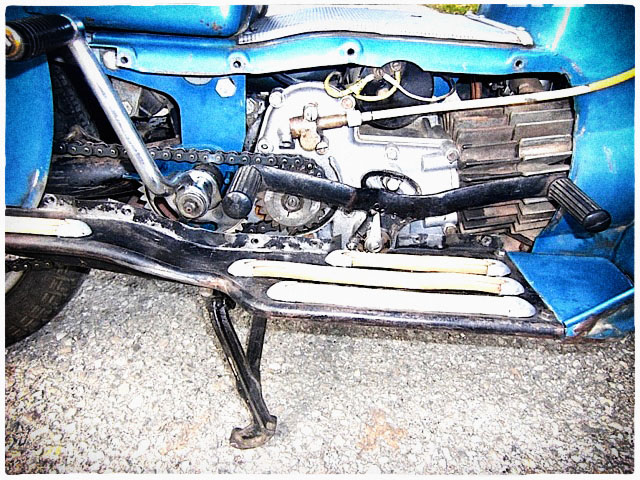 Another feature that is not expected on a vehicle that has more than half a century is the driver comfort, even greater comfort than modern motorcycles thanks to a comfortable seat all covered in leather and a handlebar position that leaves the arms and wrists relaxed; excellent protection from the wind on the legs thanks to the large front shield.
Another feature that is not expected on a vehicle that has more than half a century is the driver comfort, even greater comfort than modern motorcycles thanks to a comfortable seat all covered in leather and a handlebar position that leaves the arms and wrists relaxed; excellent protection from the wind on the legs thanks to the large front shield.

What remains of the Galletto in motorcycle history today is certainly the idea of Carlo Guzzi to create a revolutionary vehicle not yet present in the post-war motorcycle market.
Carlo Guzzi can therefore undoubtedly be called the inventor of the “motorcycle-scooter” hybrid segment, which today, 70 years later, is a part of the market that is still very present and in great expansion.
GALLETTO MOTO GUZZI MANUAL FOR DISSAMBLEY CONTROL
[pdfviewer width=”620px” height=”849px” beta=”true/false”]https://www.romecentral.com/wp-content/uploads/2020/02/GALLETTO-192-cc.-MANUALE-PER-LE-OPERAZIONI-DI-_-SMONTAGGIO-CONTROLLO-E-MONTAGGIO.pdf[/pdfviewer]
TECHNICAL SPECIFICATION
Modello (Model): GALLETTO
Anno (Year): 1954
Tipo: Moto Epoca
Categoria: scooter d’epoca
Ciclistica (Chassis)
Telaio ( Frame type): In profilati di lamiera
Inclinazione canotto (Rake fork angle):
Sospensione anteriore (Front suspension): Forcella telescopica con bracci oscillanti
Sospensione posteriore (Rear suspension): Braccio oscillante con ammortizzatori a frizione
Freno anteriore (Front brakes): Tmburo
Freno posteriore (Rear brakes): Tmburo
Pneumatico anteriore (Tires Front): 2.75-17
Pneumatico posteriore (Tires Rear): 3.00-17
Ruota anteriore (Front wheel):
Ruota posteriore (Rear wheel):
Motore (Engine)
Tipo di motore (Engine type): Monoilindrico orizzontale, 4 tempi
Cilindrata (Displacement): 192 cc
Alesaggio per corsa (Bore Stroke):
Compressione (Compression ratio): 5,6 : 1
Valvole per cilindro (Valve): 2
Alimentazione (Fuel System): Carburatore Dell’Orto
Raffreddamento (Cooling system):
Quantità olio (Oil capacity): 3 Lt
Avviamento (Starter): Pedale
Potenza (Power):
Copia massima (Torque):
Scarico (Exhaust):
Dimensioni e Peso (Dimentions and Weight)
Lunghezza (Overall Length):
Larghezza (Overall Width):
Altezza (Overall Height):
Altezza sella (Seat Height):
Interasse (Ground Clearance): 1.310 mm
Distanza minima da terra (Wheelbase):
Peso a vuoto (Dry Weight): 107 Kg
Peso in ordine marcia ():
Serbatoio (Fuel Tank Capacity): 7 Lt
Trasmissione (Trasmission):
Cambio (Gearbox): 4 marce
Frizione (Clutch): Multidisco
Trasmissione finale (Final drive): Catena
Prestazioni
Velocità massima (Max Speed): 85 Kmh
400 mt:
Emissioni e consumi:
Standard:
Altro
Colore (Colours): Avorio
Caratteristiche tecniche – Moto Guzzi Galletto 160cc 1950÷52
Dimensioni e pesi
Interasse: 1310 mm Massa a vuoto: 107 kg Serbatoio: 7 litri
Meccanica
Tipo motore: monocilindrico orizzontale quattro tempi Raffreddamento: ad aria
Cilindrata 159,5 cm³ (Alesaggio 62,0 x Corsa 53,0 mm)
Distribuzione: aste e bilancieri Alimentazione: un carburatore Dell’Orto MA 18 BS 1
Potenza: 6 CV a 5200 giri/min Coppia: Rapporto di compressione:
Frizione: multidisco in bagno d’olio Cambio: sequenziale a 3 marce (sempre in presa) con comando a pedale
Accensione a volano magnete Marelli o Filso
Trasmissione primaria a ingranaggi; secondaria a catena
Avviamento a pedale
Ciclistica
Telaio in profilati e lamiera
Sospensioni Anteriore: forcella telescopica e bracci oscillanti / Posteriore: forcellone oscillante e due ammortizzatori a frizione
Freni Anteriore: a tamburo / Posteriore: a tamburo
Pneumatici anteriore 2.75-17″; posteriore 3.00-17″
Prestazioni dichiarate
Velocità massima 80 km/h
Consumo 2,6 l/100 km
Laureando in giurisprudenza appassionato di giornalismo, di politica e del mondo dei motori.

